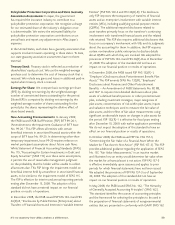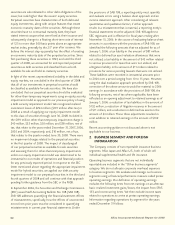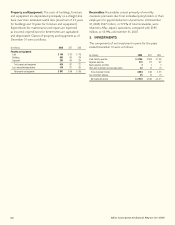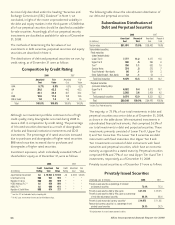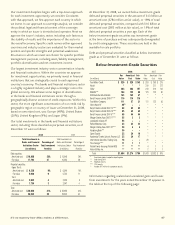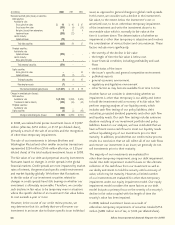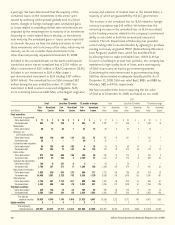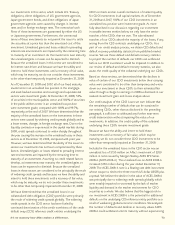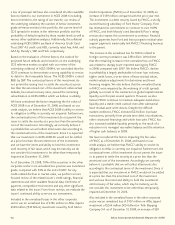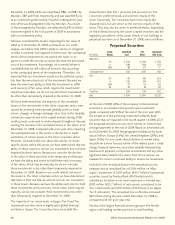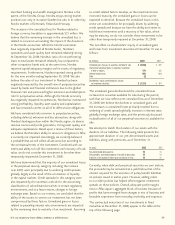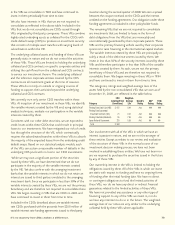Aflac 2008 Annual Report Download - page 73
Download and view the complete annual report
Please find page 73 of the 2008 Aflac annual report below. You can navigate through the pages in the report by either clicking on the pages listed below, or by using the keyword search tool below to find specific information within the annual report.
69
It’s no mystery how Aflac makes a difference.
These other-than-temporary impairment losses primarily
consisted of $294 million ($191 million after-tax) recognized
on certain of our perpetual security investments; $213 million
($139 million after-tax) recognized on certain of our CDO
investments; $180 million ($117 million after-tax) recognized
on our investments in three Icelandic banks; and $65 million
($42 million after-tax) recognized on our investment in Ford
Motor Company.
In connection with our decision to reclassify all of our
perpetual securities to available for sale, we also concluded
that our perpetual securities should be evaluated for
other-than-temporary impairments using an equity security
impairment model as opposed to our previous policy of using
a debt security impairment model for periods ending on and
before June 30, 2008. In connection with this decision, we
recognized an impairment charge of $294 million ($191 million
after-tax) in the third quarter of 2008 from the application
of our equity security impairment policy to this asset class
through June 30, 2008. As more fully described in the SEC
Guidance section of Note 1, the June 30 valuation date was
used following the SEC’s letter to the FASB on the topic of
the appropriate impairment model to apply to perpetual
securities. In response to the SEC’s letter, we applied our debt
security impairment model to our perpetual securities in the
third and fourth quarters of 2008 and will continue with that
approach pending further guidance from the SEC or the FASB.
During 2009, the outlook for the financial markets has
continued to deteriorate globally. In connection with this
downward trend, certain of the investment securities we own
have been downgraded by various rating agencies since year end.
We apply the debt security impairment model to our perpetual
securities provided there has been no evidence of deterioration
in credit of the issuer, such as a downgrade of the rating of a
perpetual security to below investment grade. Subsequent to
December 31, 2008, and through the date of this report, the
outlook for the financial markets has continued to deteriorate
globally. In connection with this downward trend, certain of
the perpetual securities we own have been downgraded to
below investment grade subsequent to December 31, 2008.
As a result of these downgrades, we are required to evaluate
the securities for other-than-temporary impairment using the
equity security impairment model rather than the debt security
impairment model. Use of the equity security model limits the
forecasted recovery period that can be used in the impairment
evaluation and, accordingly, affects both the recognition and
measurement of other-than-temporary impairment losses. As a
result of market conditions and the extent of changes in ratings
on our perpetual securities, we will incur additional other-than-
temporary impairment losses beginning in 2009, which could
materially affect our results of operations for a particular fiscal
quarter or year.
As a part of our credit review process, we concluded that it
had become unlikely that we would recover our full investment
in certain of our CDO investments as a result of continued
significant declines in the credit markets during the fourth
quarter of 2008. In accordance with our investment policy,
we recorded an impairment charge of $164 million ($106
million after-tax) in connection with the other-than-temporary
impairment of these CDOs during the fourth quarter of 2008.
We also recorded other-than-temporary impairment charges
of $49 million ($32 million after-tax) during the second half
of 2008 in connection with CDO investments transferred to
available for sale as a result of a default by the related swap
counterparty, Lehman Brothers Special Financing Inc. (LBSF).
We hold investments in three Icelandic banks, Glitnir,
Landsbanki and Kaupthing, in the form of junior subordinated
debt, some of which include perpetual securities. During the
fourth quarter of 2008, the Icelandic government passed
legislation that allowed certain distressed Icelandic financial
institutions to be placed into receivership under the control
of the Icelandic government. Following the passage of this
legislation, the above noted Icelandic banks were placed into
receivership and are now being operated by the Icelandic
government, which is also in financial distress. Subsequent to
these actions, we learned that it was unlikely that the banks or
the Icelandic government have any intent to honor the banks’
obligations beyond their domestic depositors. As a result, we
recognized a loss of $180 million ($117 million after-tax) in the
fourth quarter of 2008 to reflect the other-than-temporary
impairment of our total investment in these securities. Our
investments in Glitner, Landsbanki and Kaupthing were
classified as below investment grade as of December 31, 2008.
In 2007, we realized pretax investment gains of $28 million
(after-tax, $19 million, or $.04 per diluted share) primarily as
a result of securities sold or redeemed in the normal course
of business. In 2006, we realized pretax gains of $79 million
(after-tax, $51 million, or $.10 per diluted share) primarily as a
result of bond swaps and the liquidation of equity securities
held by Aflac U.S. We began a bond-swap program in the
second half of 2005 and concluded it in the first half of 2006.
These bond swaps took advantage of tax loss carryforwards
and also resulted in an improvement in overall portfolio credit
quality and investment income.
The table on the following page shows the gross unrealized
losses and fair values of our investments with unrealized losses
that we consider to be temporary, aggregated by investment
category and length of time that individual securities have
been in a continuous unrealized loss position at December 31.
As of December 31, 2008, 96% of our investments in the
banks and financial institutions sector in an unrealized
loss position was investment grade, compared with 100%


